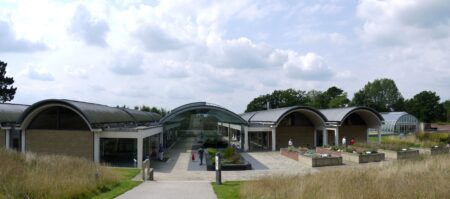- A little more safety for Ukraine’s seeds, thanks to a new genebank.
- A little more safety for Mexico’s native maize, thanks to Pres. Sheinbaum.
- A little more safety for Andean agriculture, thanks to Ecuadorian Indigenous women and Inside Mater in Peru.
- A little more safety for Ischia’s zampognaro bean and Amalfi’s lemons, thanks to local people (and GIAHS).
- A little more safety for Pacific crops, thanks to cryopreservation. Breadfruit next?
- A little more safety for moringa? At least in Africa with all its “opportunity crops”?
Happy birthday MSB!!!
It’s the 25th birthday of Kew’s Millennium Seed Bank (MSB) at Wakehurst in West Sussex.

Understandably, it’s getting a lot of — very well-deserved — coverage. I’ll link to some of the more interesting pieces as they come out over the next few days.
- There’s a podcast hosted by King Charles, no less.
- The Guardian’s podcast is shorter and less cool but ok.
- Cate Blanchett is appearing in that royal podcast, as well as various more plebeian interviews. She’s the MSB’s first ever ambassador. She was recently featured, along with Wakehurst, in House & Garden.
- The Economist has a long piece about seed collecting for the MSB in Madagascar.
- RE:TV has produced a cool video.
- The BBC’s video is shorter and less cool but ok.
- Samara, the International Newsletter of the Millennium Seed Band Partnership, has a very comprehensive anniversary edition.
Here’s to the next 25!
Nibbles: Millennium Seed Bank 25th, NPGS, Maize germplasm, Breadfruit genebank, Banana genebank
- King Charles III talks about seeds with Dr Elinor Breman of Kew’s Millennium Seed Bank and…
- …Cate Blanchett.
- Or read about it in The Economist.
- Or watch a nice video.
- The seed banks of the National Plant Germplasm System in the USA are for farmers, not just researchers.
- How to get stuff out of the NPGS.
- Laurajean Lewis: from an NPGS genebank to CIMMYT’s.
- I’m sure she and Chris Mujjabi will get to know each other soon.
- Diane Ragone: Not all genebanks are seed banks.
- Not a lot of breadfruits in Belgium but, surprisingly, lots of bananas.
Nibbles: Fiona Hay, Richard Ellis, FAO exhibition, Peasants, Wheat breeding, Svalbard, Søren Ejlersen, Ephraim Bull, Heirloom apples, Caffeine, Collards history
- Dr Fiona Hay, seed scientist, on why we need genebanks, including seed banks.
- Prof. Richard Ellis retires. A genebank legend, as Fiona would probably agree.
- FAO exhibition goes From Seeds to Foods. By way of genebanks, no doubt.
- And peasants, of course. No, it’s not a derogatory word, settle down.
- Can Green Revolution breeding approaches (and genebanks) help peasants deal with climate change?
- Even genebanks need a back-up plan though.
- New Mexico genebank helps out Danish chef.
- The history of the Concord grape and its foxiness. Chefs intrigued.
- The history of Aport and Amasya apples. No foxiness involved, as far as I know. Genebanks? Probably.
- The origin of caffeine. Now do foxiness.
- Where did collards come from anyway? No, not genebanks. Bloody historians, always re-writing history.
Nibbles: Ancient Mexican seedbank, Indian millets, Foraged foods, Soybean breeding, Apple breeding, Albanian heirlooms, Bangladesh fish genebank
- People in the Nejapan Sierra Sur in Oaxaca, Mexico had a seed bank 400-700 years ago so they could re-create their complex cuisine after disruptions.
- How MSSRF revived millets in Odisha, India. You think a seed bank was involved?
- Meanwhile, in Meghalaya (also India), foraged foods are helping to diversify state-provided school lunches and address chronic malnutrition. Talk about complex cuisine. Are all these species in a seed bank somewhere, though? Do they need to be?
- How the National Soybean Germplasm Collection at the Agricultural Research Service lab in Urbana, Illinois helped save soybeans in Iowa.
- University breeding programmes are keeping the apple afloat in the USA. That and genebanks.
- Farmers and agrotourism are bringing back some cool flavors in Albania. Well, that and the Albanian Gene Bank.
- Fish need genebanks too, and Bangladesh is on it. Did ancient Bangladeshis have them, I wonder?